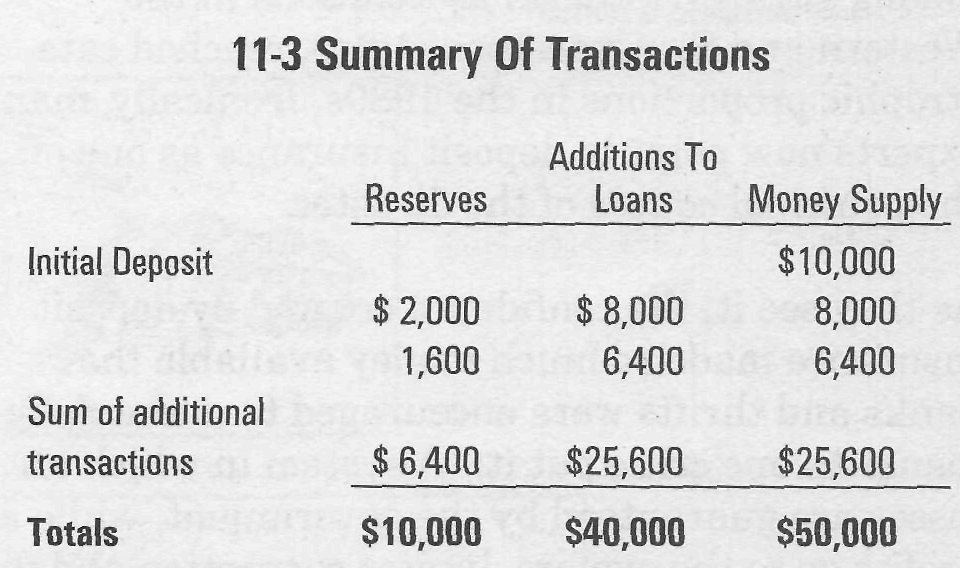
- •Chapter 11 money & financial institutions
- •11.1. Money
- •11.2. Money Today
- •11.3. The Development of Banking
- •11.4. Banking Today
- •11.5. How the Banking System "Creates" Money
- •11.6. The Federal Reserve System
- •11.7. The Value of Money Can Change
- •11.8. What are the Causes of Inflation?
- •11.9. Who Suffers or Benefits from Inflation?
11.6. The Federal Reserve System

Following a series of painful recessions between 1873 and 1907, the National Monetary Commission was established to recommend ways to improve the banking system. Its proposals led to the creation of the Federal Reserve System by Congress in 1914. The Federal Reserve System, or "the Fed," as it is commonly called, is the nation's central bank. It is responsible for issuing paper currency, implementing monetary policies, and with other agencies, supervising commercial banks. The Federal Reserve System consists of 12 District Banks, a Board of Governors, and two committees-the Open Market Committee and the Federal Advisory Council.
• District Banks. The Federal Reserve System is built around 12 geographic districts. District Federal Reserve banks supervise banking in each of these areas.
• Board of Governors. The Board of Governors establishes policies for the system. It consists of seven persons appointed by the president for 14-year terms.
• Open Market Committee. The Open Market Committee is made up of the seven members of the Board of Governors and presidents of five of the district banks. Its primary responsibility is to regulate the nation's money supply.
• Federal Advisory Council. The Federal Advisory Council does just that: it offers advice on the nation's financial problems. It is made up of 12 prominent commercial bankers, one selected from each district.
As you will discover in this chapter and in Chapter 12, the Federal Reserve System has four distinct roles that profoundly affect the economy:
• Provide banking services for financial institutions;
• Serve as the federal government's bank;
• Regulate and supervise member banks;
• Develop and carry out monetary policy.
Provide Banking Services for Financial Institutions. The Fed provides the kinds of services for banks that banks provide for the public.
• Supply cash. Just as you would go to your bank to withdraw cash when you need it, banks draw currency from their accounts with their district Federal Reserve bank.
• Process checks. When individuals, business firms, and others receive checks, they usually deposit them in their banks. There, the checks are credited to the depositors' accounts and passed along for collection from the institution on which they were drawn. Most checks drawn on banks other than the one in which they were deposited are presented to the district banks for collection.
• Hold deposit accounts. Banks keep their reserves and other funds on deposit in an account at their district bank.
• Make loans. Financial institutions, like most businesses, must borrow from time to time. When this happens, they can go to the Fed for a loan.
• Transfer funds. The Federal Reserve System's wire services and computers enable local banks to transfer funds from one to the other almost instantaneously.
Serve as Banker to the Federal Government.
The Federal Reserve District Banks are the federal government's bankers. They maintain the Treasury Department's "checking account" and issue and redeem government bonds and other securities.
Supervise and Regulate the Nation's Banking System. The Federal Reserve System, along with numerous other agencies, is charged with establishing the rules of behavior for the banking system to ensure the safety and soundness of the institutions that handle our funds. In addition to the Comptroller of the Currency and the FDIC (Federal Deposit Insurance Corporation), the Federal Reserve supervises nationally chartered and state-chartered banks and state banking agencies.
Manage the Supply of Money and Credit. A
major responsibility of the Fed is to develop and
carry out monetary policy. Decisions made at the Fed about the money supply and credit can have a major effect on the economy.
